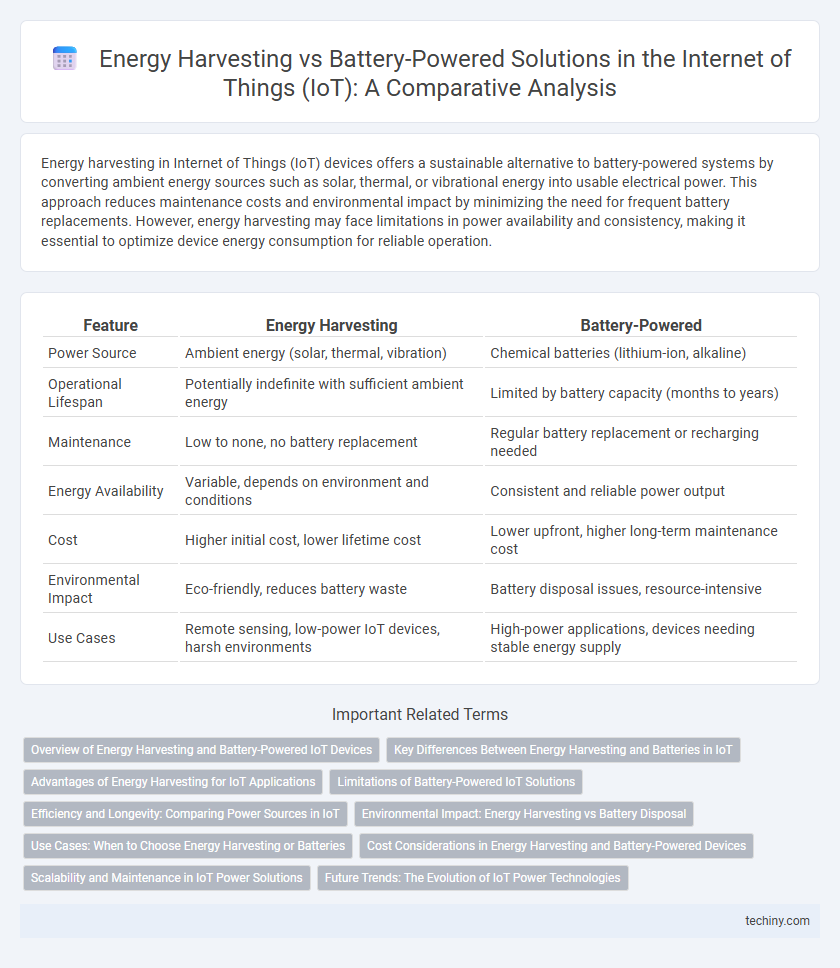Energy harvesting in Internet of Things (IoT) devices offers a sustainable alternative to battery-powered systems by converting ambient energy sources such as solar, thermal, or vibrational energy into usable electrical power. This approach reduces maintenance costs and environmental impact by minimizing the need for frequent battery replacements. However, energy harvesting may face limitations in power availability and consistency, making it essential to optimize device energy consumption for reliable operation.
Table of Comparison
| Feature | Energy Harvesting | Battery-Powered |
|---|---|---|
| Power Source | Ambient energy (solar, thermal, vibration) | Chemical batteries (lithium-ion, alkaline) |
| Operational Lifespan | Potentially indefinite with sufficient ambient energy | Limited by battery capacity (months to years) |
| Maintenance | Low to none, no battery replacement | Regular battery replacement or recharging needed |
| Energy Availability | Variable, depends on environment and conditions | Consistent and reliable power output |
| Cost | Higher initial cost, lower lifetime cost | Lower upfront, higher long-term maintenance cost |
| Environmental Impact | Eco-friendly, reduces battery waste | Battery disposal issues, resource-intensive |
| Use Cases | Remote sensing, low-power IoT devices, harsh environments | High-power applications, devices needing stable energy supply |
Overview of Energy Harvesting and Battery-Powered IoT Devices
Energy harvesting IoT devices convert ambient energy sources such as solar, thermal, or kinetic energy into electrical power, enabling sustainable, maintenance-free operation. Battery-powered IoT devices rely on stored chemical energy, providing consistent power but requiring periodic replacement or recharging, which impacts device longevity and environmental footprint. Hybrid systems combining energy harvesting with battery power optimize reliability and energy efficiency, crucial for remote or inaccessible IoT deployments.
Key Differences Between Energy Harvesting and Batteries in IoT
Energy harvesting in IoT devices converts ambient energy sources like solar, thermal, or vibration into electrical power, enabling sustainable and maintenance-free operation, whereas battery-powered IoT devices rely on stored chemical energy with limited lifespan and require periodic replacement or recharge. Energy harvesters offer continuous energy supply with minimal environmental impact but typically provide lower power output compared to batteries, making them ideal for low-power, long-term sensor networks. Battery-powered solutions excel in high-power demand scenarios and provide reliable, consistent energy but pose challenges in terms of weight, disposal, and operational lifetime in large-scale IoT deployments.
Advantages of Energy Harvesting for IoT Applications
Energy harvesting for IoT applications offers sustainable, long-lasting power by capturing ambient energy sources such as solar, thermal, or kinetic energy, reducing dependency on batteries and minimizing maintenance. This technology enhances device autonomy and reliability in remote or hard-to-access locations, eliminating frequent battery replacement and associated costs. Efficient energy harvesting supports continuous operation and contributes to environmental sustainability by lowering electronic waste from disposable batteries.
Limitations of Battery-Powered IoT Solutions
Battery-powered IoT solutions face significant limitations including limited lifespan, frequent maintenance, and environmental concerns due to battery disposal. The finite energy storage capacity restricts device operation time, especially in remote or hard-to-reach locations where replacement is costly and labor-intensive. Additionally, battery degradation over time reduces reliability, posing challenges for long-term, autonomous IoT deployments.
Efficiency and Longevity: Comparing Power Sources in IoT
Energy harvesting in IoT devices offers continuous power by converting ambient energy sources such as solar, thermal, or vibrational energy, significantly enhancing device longevity without frequent maintenance. Battery-powered IoT systems provide stable and predictable energy output but suffer from limited lifespan and require periodic replacement, impacting efficiency in long-term deployments. Efficiency in energy harvesting depends on environmental conditions, making hybrid systems combining both methods a promising solution for optimizing power management in IoT networks.
Environmental Impact: Energy Harvesting vs Battery Disposal
Energy harvesting in Internet of Things (IoT) devices significantly reduces environmental impact by minimizing reliance on disposable batteries, which contribute to hazardous waste and soil contamination. Unlike battery-powered IoT devices that require frequent replacements and complex recycling processes, energy harvesting utilizes ambient energy sources like solar, thermal, or kinetic energy, promoting sustainability and extending device lifespan. This shift lowers carbon footprints and aligns with green technology goals by reducing toxic chemical leakage and resource depletion associated with battery production and disposal.
Use Cases: When to Choose Energy Harvesting or Batteries
Energy harvesting is ideal for IoT use cases involving remote sensors or devices in inaccessible locations where battery replacement is costly or impractical, such as agricultural monitoring and structural health applications. Battery-powered IoT devices excel in high-energy-demand scenarios like wearable health trackers and industrial automation equipment that require consistent, reliable power output. Selecting between energy harvesting and batteries depends on factors including power availability, maintenance feasibility, and device lifespan requirements.
Cost Considerations in Energy Harvesting and Battery-Powered Devices
Energy harvesting devices reduce long-term costs by eliminating the need for battery replacements and maintenance, making them ideal for remote or hard-to-access IoT deployments. Battery-powered devices involve higher operational expenses due to periodic battery procurement, disposal, and associated labor, which can escalate total ownership costs over the device lifecycle. Initial investment in energy harvesting technology may be higher, but the total cost of ownership decreases significantly with scalable, maintenance-free energy solutions for sustainable IoT applications.
Scalability and Maintenance in IoT Power Solutions
Energy harvesting enables scalable IoT deployments by reducing reliance on battery replacements, which significantly lowers maintenance efforts and costs, especially in large sensor networks. Battery-powered devices require regular servicing to replace or recharge cells, limiting scalability due to logistical challenges and downtime risks. Integrating energy harvesting technologies like solar, thermal, or vibration sources optimizes long-term sustainability and enhances IoT system reliability across widespread applications.
Future Trends: The Evolution of IoT Power Technologies
Energy harvesting technologies in IoT devices are rapidly evolving to provide sustainable, long-term power solutions by capturing ambient energy sources such as solar, thermal, and vibrational energy, reducing reliance on traditional batteries. Advances in ultra-low-power electronics and energy-efficient wireless communication protocols are enabling IoT nodes to operate autonomously with minimal maintenance. Future trends indicate a hybrid approach combining energy harvesting with intelligent power management systems, enhancing device longevity and supporting more extensive, scalable IoT networks.
energy harvesting vs battery-powered Infographic

 techiny.com
techiny.com